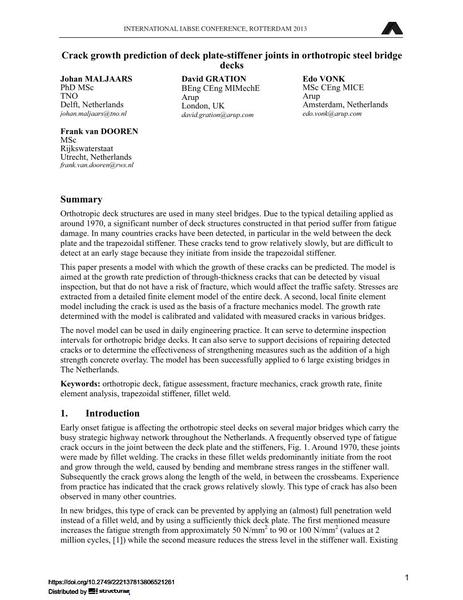Crack growth prediction of deck plate-stiffener joints in orthotropic steel bridge decks

|
|
|||||||||||
Bibliographic Details
| Author(s): |
Johan Maljaars
David Gration Edo Vonk Frank van Dooren |
||||
|---|---|---|---|---|---|
| Medium: | conference paper | ||||
| Language(s): | English | ||||
| Conference: | IABSE Conference: Assessment, Upgrading and Refurbishment of Infrastructures, Rotterdam, The Netherlands, 6-8 May 2013 | ||||
| Published in: | IABSE Conference, Rotterdam, May 2013 | ||||
|
|||||
| Page(s): | 502-503 | ||||
| Total no. of pages: | 8 | ||||
| Year: | 2013 | ||||
| DOI: | 10.2749/222137813806521261 | ||||
| Abstract: |
Orthotropic deck structures are used in many steel bridges. Due to the typical detailing applied as around 1970, a significant number of deck structures constructed in that period suffer from fatigue damage. In many countries cracks have been detected, in particular in the weld between the deck plate and the trapezoidal stiffener. These cracks tend to grow relatively slowly, but are difficult to detect at an early stage because they initiate from inside the trapezoidal stiffener. This paper presents a model with which the growth of these cracks can be predicted. The model is aimed at the growth rate prediction of through-thickness cracks that can be detected by visual inspection, but that do not have a risk of fracture, which would affect the traffic safety. Stresses are extracted from a detailed finite element model of the entire deck. A second, local finite element model including the crack is used as the basis of a fracture mechanics model. The growth rate determined with the model is calibrated and validated with measured cracks in various bridges. The novel model can be used in daily engineering practice. It can serve to determine inspection intervals for orthotropic bridge decks. It can also serve to support decisions of repairing detected cracks or to determine the effectiveness of strengthening measures such as the addition of a high strength concrete overlay. The model has been successfully applied to 6 large existing bridges in The Netherlands. |
||||
| Keywords: |
finite element analysis FEA fillet weld orthotropic deck fatigue assessment fracture mechanics crack growth rate trapezoidal stiffener
|
||||
